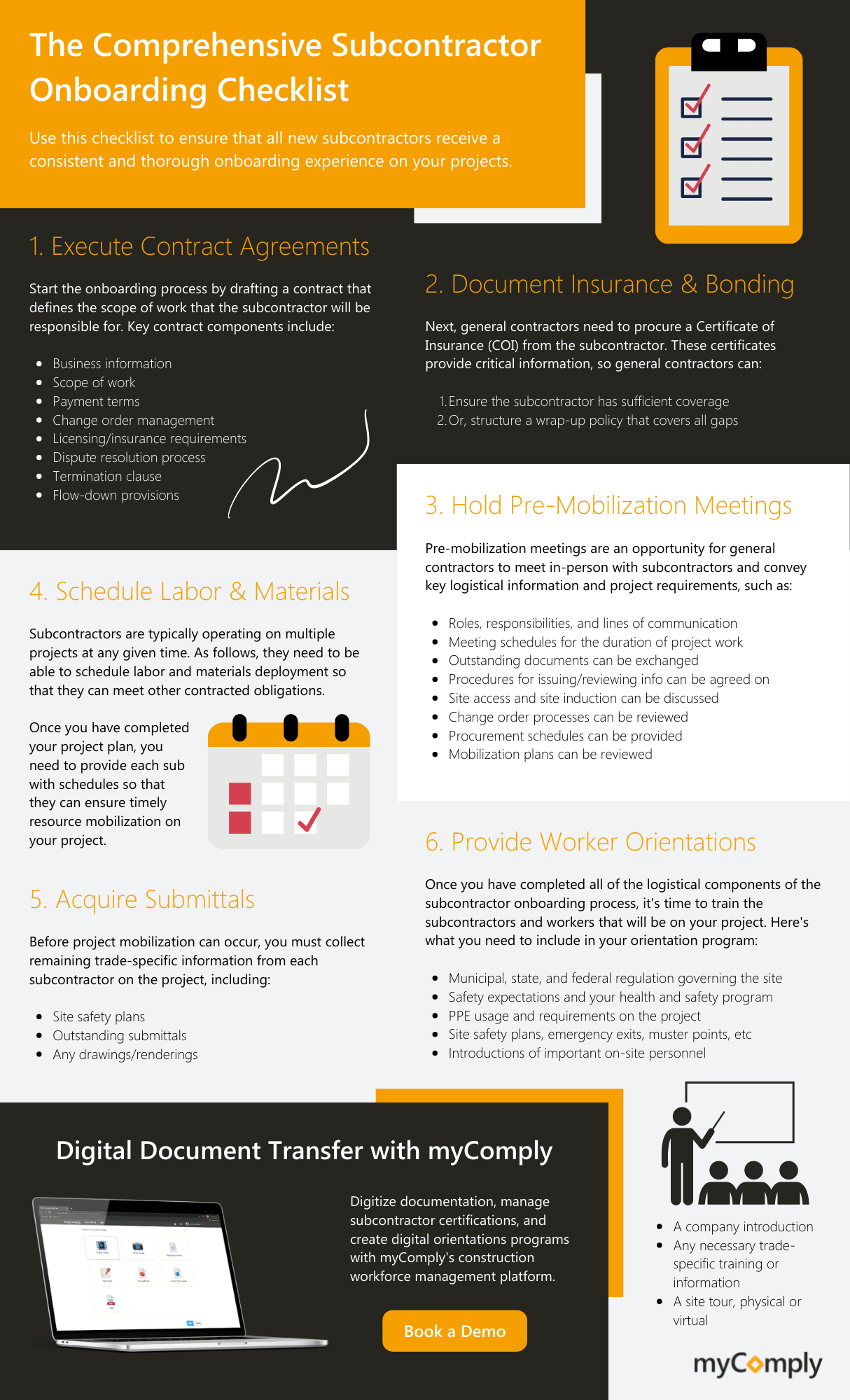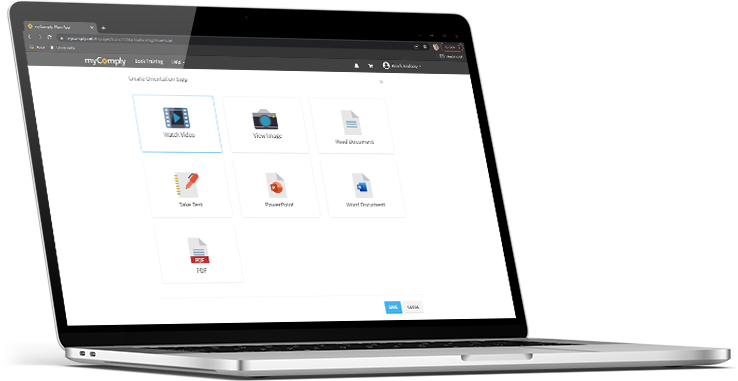With the start of every new construction project, comes a new subcontractor onboarding phase. Though your safety protocols do not change, the subcontractors on the project, the risks at play, and other site-specific challenges do. That is why it is paramount that all general contractors have an iron-clad subcontractor onboarding checklist to help them get subs on-site quickly while also preventing future incidents on the project.
This article explains why subcontractor onboarding is an essential piece of the safety puzzle, provides you with a detailed onboarding checklist, and explores how construction onboarding software can enable you to slash costs and improve operational efficiencies.
Table of Contents
Subcontractor Onboarding: Why It is Essential
Proper Onboarding Saves Time and Money
Documented Training Minimizes Insurance Risk
Contractors Must Meet the Terms of the OSHA Act
New Workers are the Greatest Safety Risk
The Comprehensive Subcontractor Onboarding Checklist
1. Execute Subcontractor Contract Agreements
2. Document Proof of Insurance and Bonding
3. Schedule Pre-Mobilization Meetings
4. Schedule Labor and Materials Deployment
5. Acquire Submittals
6. Subcontractor/Worker Orientations
Construction Onboarding Software
myComply: The Leading Construction Onboarding Solution
Conclusion
Subcontractor Onboarding: Why It is Essential
A proper subcontractor onboarding framework is critical to the safety and sustainability of construction projects. Without a robust process in-place, subcontractors and workers might not receive the company-specific, project-specific, or trade-specific information/training that they need to conduct safe work on a project site.
Here are some of the top reasons to invest in your construction onboarding process:
Proper Onboarding Saves Time and Money
According to Jim Stengel, Senior Risk Engineer at AXA XL and former Director of Safety at Tilden Coil Constructors, site Superintendents and other project management assets spend up to 65% of their time onboarding and training workers.
Though this might seem like a substantial cost, the cost of incident or injury resulting from an untrained worker is MUCH greater. In fact, stop work orders can cost general contractors hundreds of thousands in fines and insurance-related costs and can lead to project delays that could impact liquidated damages enforcement if the project is not completed on schedule.
Therefore, a strong construction onboarding program should not be seen as a cost center, but rather an investment in the future outcomes of work on the project. This is particularly true if general contractors leverage a digital construction onboarding platform to reduce the time site safety personnel spend orientating new workers.
Learn more about myComply’s construction onboarding software!
Documented Training Minimizes Insurance Risk
Depending on the nature of your insurance arrangements, your coverage might be hinged on variables such as the successful and proven completion of a site safety orientation. Therefore, failure to properly onboard a worker could lead to a gap in coverage, leading contractors to pay for the costs of an incident out-of-pocket.
What is the cost of an uninsured incident on a construction project? According to the National Safety Council, accidents involving uninsured workers can cost upwards of $1,220,000. With numbers like that in-play, you cannot afford not to invest in construction onboarding.
Contractors Must Meet the Terms of the OSHA Act
Under the OSHA Act, employers are required to provide safe and healthful workplaces for their workers. Failure to do so can lead to large fines from an OSHA authority. In fact, single fines can cost contractors $14,502 per violation and failure to remediate can lead to much greater fines, (up to $145,027 per violation).
New Workers are the Greatest Safety Risk
There is a labor shortage in construction. In fact, as of March 2022, the construction industry faces a shortage of roughly 650,000 workers, beyond normal hiring levels. With so many new workers expected to be entering the workforce, there will be a lot of training required if contractors want to prevent incident and injury on their sites.
Why is that? According to a University of Tennessee study, 30.1% of injuries in the Tennessee construction industry involved workers with six months or less experience, with almost 45% of injuries involving workers that have been with their employers for less than one year.
Each of these incidents leads to extensive costs to general contractors. According to the National Safety Council, contractors pay $1,100 for each injury, $44,000 for each medically diagnosed injury, and $1.31 million for each death on their projects.
In other words, a strong construction onboarding programs have never been more important.
Learn more: New Contractor Orientation: Ensuring Successful Worker Onboarding
The Comprehensive Subcontractor Onboarding Checklist
Onboarding can occur at various levels in the construction industry, be it company-specific, project-specific, trade-specific, or otherwise. This subcontractor onboarding checklist will focus on the company and project-specific onboarding processes and orientations that general contractors must organize and conduct to promote safe, organized, and sustainable project work.

1. Execute Subcontractor Contract Agreements
Construction projects are contract rich. Once bidding has concluded and a subcontractor has been selected, the first step in the onboarding process is to execute a subcontractor contract agreement that defines the portion of work that the subcontractor will be responsible for completing.
General contractors are the intermediary between the asset owner and the subcontractor, so these contracts are important vehicles to protect both the general contractor and the subcontractor against various types of construction risk.
Here are the key items to include in your subcontractor agreements:
- Business information for both parties
- Scope of work and project schedule
- Payment terms
- Change order management
- Licensing and insurance documentation
- Dispute resolution
- Termination clause
- Flow down provisions
Read our full article on subcontractor agreements to find out more!
2. Document Proof of Insurance and Bonding
Once contracts have been executed, general contractors need to procure the Certificate of Insurance (COI) from the subcontractor, which will have an expiration date that must be tracked. COIs contain all the essential details regarding the subcontractors existing insurance coverages, including:
- Policyholder details
- Policy effective dates
- Types of coverage
- Policy limits
Certificates of insurance provide general contractors with quick access to critical insurance information so that they can either:
- Ensure that the subcontractor has sufficient coverage for the scope of work that they are being contracted for (under a traditional insurance model).
- Structure a wrap-up policy that covers any gaps that there might be between the subcontractor’s current coverage and coverages needed for the project.
Interested in simplifying certification tracking? Learn how you can digitize all your construction certifications, automate expiration reminders, and make documentation accessible on any cloud-connected device with myComply.
3. Schedule Pre-Mobilization Meetings
Pre-mobilization meetings are important (sometimes optional) events where the general contractor discusses key project details with the subcontractor, including logistics and project-specific requirements.
The benefits to pre-mobilization meetings are as follows:
- In-person introductions can be made
- Roles, responsibilities, and lines of communication can be discussed and clarified
- Meeting schedules can be crafted for the duration of the project work
- Any outstanding documents can be exchanged
- Procedures for monitoring, issuing, receiving, and reviewing information can be agreed upon
- Conversations can be had regarding site access, site induction, health, and safety concerns, change order management, and more
- General contractors can deliver procurement schedules
- Mobilization schedules can be provided
4. Schedule Labor and Materials Deployment
Subcontractors need to plan when and how they will send labor and materials to the project site, especially on projects with long lead times. Once the general contractor and the asset owner have completed their project plan, they need to provide these schedules to subcontractors so that they can ensure timely resource mobilization.
5. Acquire Submittals
Before project mobilization occurs, subcontractors must send all their trade-specific information, including Site Safety Plans, submittals, and drawings/renderings. This documentation must then be approved by the general contractor before resource mobilization on the project occurs.
6. Subcontractor/Worker Orientations
Once all the logistical components have been taken care of, it is time to provide project specific training to the subcontractors and workers that will be executing against your project plan.
Here is what you need to include in your new contractor orientation program:
- Municipal, state, and federal regulation governing the site
- A company introduction
- Safety expectations as well as your health and safety program
- PPE (Personal Protective Equipment) usage and requirements
- A site tour (physical or virtual)
- Site safety plans, emergency exits, muster points, etc.
- Introductions of important on-site personnel
- Any necessary trade-specific training/information
Read our complete article on new contractor orientations to find out more!
Construction Onboarding Software
Construction onboarding software gives general contractors the power to transform a cost-bucket into an efficiency driver.
Here are the key benefits to construction onboarding software:
- Workers start faster. Instead of spending paid, on-site time training workers, they can complete most of their training online before ever stepping foot on the project. Upon arrival, it can be as simple as a verification of identification, then workers might be able to start work.
- Save valuable time and money. By alleviating up to 95% of the time that a Site Superintendent would otherwise spend on orientations, you are opening the door to more value-added work that can be done to keep your project on-track.
- Eliminate paperwork. Rather than issuing paper copies to verify completion of onboarding, contractors can issue digital certificates that are stored in the cloud and can be accessed anywhere, anytime.
- Create worker or trade-specific training packages. Instead of providing the same general orientation to all workers, contractors can create different training packages and provide a greater degree of prescription to each worker, based on the work they will be conducting on the project.
Construction onboarding software can effectively save contractors tens of thousands of dollars per project and help provide more detailed and consistent training than is otherwise possible.
myComply: The Leading Construction Onboarding Solution
myComply is a construction workforce management platform that enables general contractors to unlock operational efficiencies and slash costs by turning worker movements into powerful data drivers. The first feature in the platform is a robust orientations module.
Here’s how myComply’s orientations module works:
1. Create Custom Courses
myComply’s orientations module makes construction onboarding easy by enabling general contractors to create digital orientations at the project-level, company-level, trade-level, or anything else that the contractor may require.
Our software also supports a variety of course styles, making it possible to upload content in the following formats:
- Video or YouTube URL
- Microsoft Office and Word
- Image
- Custom Notes
- Custom Exams

Source: myComply Orientations
2. Track Construction Onboarding Completions
Once you have built your construction onboarding modules, myComply makes it possible to pair each orientation to a unique worker profile that can be tracked. General contractors can then monitor completions through their myComply dashboard.
3. Unlock Other Workforce Management Solutions
Orientations is just the first of many features included in myComply’s Projects Pro platform. Once you have created your online construction onboarding materials, you are ready to unlock to rest of the myComply platform.
With myComply, general contractors can take their certification tracking to the next level, by setting certification requirements for each subcontractor and worker, enabling certs to be digitized and accessed by any authorized smart device. Contractors can then use these digital documents to establish certification-based access control.
Here is how it works:
- We install myComply Smart Bricks on your access points (turnstile gate, door strike, or other entry point).
- Each worker is issued a Smart Badge which is paid with their worker profile (where certifications are stored).
- Workers actively scan their badges on Smart Bricks (using NFC technology) or they passively check-in when they enter certain regions of a project site (using Bluetooth technology). Workers are only permitted site access if they meet the predetermined certification requirements.
The cherry on-top of it all? myComply tracks worker time and attendance in the background of everything else, automating time and attendance data and producing on-demand reports to display worker movements, hours, etc.
Interested in finding out more? Book some time with a product expert today.
Conclusion
Leveraging a subcontractor onboarding checklist is a sure-fire way to ensure a seamless onboarding experience that will protect both parties from liability and promote safe operations on your construction projects.
Remember the six-steps in the subcontractor onboarding process:
- Execute Subcontractor Contract Agreements
- Document Proof of Insurance and Bonding
- Schedule Pre-Mobilization Meetings
- Schedule Labor and Materials Deployment
- Acquire Submittals
- Subcontractor/Worker Orientations
And do not forget to download a copy of you subcontractor onboarding checklist!
myComply is the leading construction workforce management solution for general contractors that want to streamline their subcontractor onboarding process by digitizing the document transfer process, document critical information (like insurance), and receive automated reminders for submittals, expiration dates, and more.
Book some time with a product expert today to find out more!


